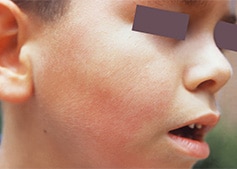PDF 72 KB
Information on Parvovirus including methicillin-resistant Staphylococcus aureus (MRSA) - including symptoms, treatment and prevention
Parvovirus B19 is a virus that commonly infects humans. Dogs and cats may be immunised against ‘parvovirus’, but these are animal parvoviruses that do not infect humans.
Parvovirus B19 infection is spread when an infected person talks, coughs or sneezes small droplets containing infectious agents into the air. The droplets in the air may be breathed in by those nearby. Infection may be spread by contact with hands, tissues and other articles soiled by infected nose and throat discharges.
Infection may also be transmitted from a woman to her fetus.
Once the rash appears, the person is no longer infectious. An exception to this is in infected people with immune suppression, who may remain infectious for months.
 The most common illness caused by parvovirus B19 is 'fifth disease', a mild rash illness that occurs most often in children. About 20% of infected children will have no symptoms at all. In others, early in the infection there may be mild cold-like symptoms, then 2 to 5 days later, the child typically develops a ‘slapped cheek’ rash on the face (see image) and a lacy red rash on the torso and limbs.
The most common illness caused by parvovirus B19 is 'fifth disease', a mild rash illness that occurs most often in children. About 20% of infected children will have no symptoms at all. In others, early in the infection there may be mild cold-like symptoms, then 2 to 5 days later, the child typically develops a ‘slapped cheek’ rash on the face (see image) and a lacy red rash on the torso and limbs.
The child is usually not very ill, though the rash may occasionally be itchy. The rash disappears after 7 to 10 days, although it may come and go for several weeks, often in response to heat. On recovery, the child develops lasting immunity and is protected against future infection.
Image courtesy Public Health Image Library (PHIL), Department of Health and Human Services, Centers for Disease Control and Prevention (CDC-USA)
Adults may also be infected with parvovirus B19 and may have no symptoms, or may have the typical rash of fifth disease, joint pain or swelling, or both. The joints most frequently affected are the hands, wrists and knees, usually on both sides of the body and usually getting better in a week or two, though sometimes the pain and swelling may last several months. At least 50% of adults have previously been infected with parvovirus B19 and have developed immunity, so they will not get the infection again.
Infection by parvovirus B19 generally causes only a mild illness. However, if a pregnant woman is infected, the infection may be transmitted to the fetus. In less than 5% of cases, parvovirus B19 infection may cause the unborn baby to have severe anaemia (low blood count) and the woman may have a miscarriage. This occurs more commonly if infection occurs during the first half of pregnancy. There is no evidence that parvovirus B19 infection causes birth defects or mental retardation. Still, a pregnant woman who has been exposed to parvovirus B19 should seek the advice of the doctor managing her pregnancy, although there is no universally recommended approach to monitoring of a woman in this situation.
Infection in people with a weakened immune system, or some blood disorders, can result in prolonged infection and severe anaemia.
Parvovirus B19 infection is diagnosed by a blood test. The blood test can also be used to test for immunity, to see if the person has had the infection in the past.
(time between becoming infected and developing symptoms)
4 to 14 days from exposure, though may be up to 20 days.
(time during which an infected person can infect others)
Most people with parvovirus B19 infection are not infectious once the rash appears. Immune suppressed people with parvovirus B19 infection may be infectious for long periods.
There is no antiviral drug for treatment of parvovirus B19 infection.
Image - Parvovirus (Slapped Cheek or Fifth Disease) Image courtesy Public Health Image Library (PHIL) Department of Health and Human Services Centers for Disease Control and Prevention (CDC-USA)